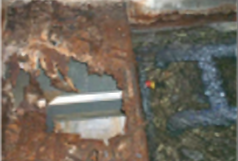



Controlled Hydrodynamic Cavitation
A Non-Chemical Water Treatment for your process.
Mainmark Group has partnered with Vortex CHC in their mission to achieve clean water for a better world.
Over the past 25 years Vortex CHC has installed thousands of CHC Systems worldwide, holds a number of worldwide patents with thousands of cooling loops, process coolers, HVAC open and closed loops and grey water effluent.
Our controlled hydrodynamic cavitation technology coupled with filtration has proven itself to be the only viable alternative to traditional water treatment methods across the spectrum of water qualities for Refrigeration, Process Cooling, and HVAC applications. The CHC integrated solution effectively controls scale, corrosion, and microbiological fouling while providing a chemical-free water stream to reuse for non-potable water applications.
CHC is the global technology leader in Controlled Hydrodynamic Cavitation treatment solutions. The CHC Solution: CHC Technology offers a proven solution for maximizing equipment operating efficiency, safety and reliability via its multi-patented cooling water treatment system.


Cavitation is the dynamic formation and collapse of micro bubbles in a fluid. The bubbles collapse through a violent process, creating an acoustic shockwave, visible light, and forcing a shift in the chemical equilibrium of calcium bicarbonate. During complete collapse, the vapor attains exceptionally high temperatures and pressures, releasing sufficient energy to destroy bacteria. CHC achieves Controlled Hydrodynamic Cavitation by forcing water through a pair of patented horizontally opposed nozzles. This harnesses the energy of the cavitation process and directs it into the water stream as opposed to material surfaces. It is this controlled energy that is the heart of the CHC solution for scale, bacteria and corrosion control.

CHC System Benefits
Scale
Control

In cooling water applications, as water temperature increases calcium will drop out of solution to form scale on heat transfer surfaces. Chemical treatments attempt to keep calcium ions in solution to prevent this calcite scale from forming, which drives up energy consumption and costs. CHC treatment increases the pH of the recirculating water, making calcium carbonate (CaCO3) insoluble. As bubbles form and collapse in the CHC treatment chamber, kinetic energy and localized temperature drive calcium carbonate from solution to form non-sticking CaCO3 solids. These solids attract dissolved calcium and carbonate ions, and are then filtered from the water stream.
Corrosion
Control

Heading 6Within the colliding water streams in a CHC chamber, a region of strong vacuum (27 .5-29.5" Hg) forms which strips dissolved CO2 from the water and helps maintain pH in an alkaline environment. Corrosive chemicals typically needed to treat scale and bacteria are not required in a CHC-treated system, which helps maintain an elevated pH. CHC controls bacteria and helps prevent any local corrosion sites due to microbiological activity, commonly referred to as Microbiologically Influenced Corrosion (MIC). CHC keeps equipment surfaces clean by removing solid particles from the cooling water with an integrated filtration system, which comes standard with every CHC water treatment program.
Bacteria Control

The extreme pressures and temperatures created by the Controlled Hydrodynamic Cavitation process physically destroy bacteria and micro biologics. Microbes and bacteria can develop resistance to traditional chemicals, requiring constant adjustment of treatment methodology. There are no such worries with CHC - bacteria cannot mutate or tolerate the physical stress as they pass through the CHC treatment chamber.
• Prevent Scale, Corrosion and Microbiological Fouling
• Reduce Water and Sewer Expenses
• Conserve Energy
• Stabilize System Operations and Costs
• Extend Equipment Life
• Eliminate Hazardous Chemicals
• Improve Environmental Health and Safety
• Minimize System Maintenance Costs


